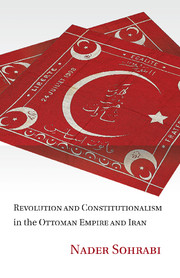7 - The Less Likely Revolution
The Constitutional Revolution of 1906 in Iran in Light of the Young Turks
from Iran
Published online by Cambridge University Press: 05 November 2011
Summary
Early in August 1906, after a series of popular confrontations with the government, the shah of Iran issued a decree that was widely interpreted as conceding a constitutional administration. In place of alleviating tensions, however, the constitutional concession managed only to heighten them, as it had in the Ottoman Empire, Russia, and France. Unlike the revolution’s largely bloodless beginning, the ensuing twenty-three months witnessed contentious fights over the functions, responsibilities, and powers of the new institution. These tensions culminated in a bloody counterrevolution that lasted a year and ended with the victory of the constitutionalists and a new monarch on the throne.
The Iranian revolution is examined here at the global, regional, and local layers, within an explicitly comparative context. The conflict’s framing under the constitution ushered in a political culture and institutions that were globally recognizable. These included a legislative assembly, national elections, a written constitution, confrontations between the monarch and the “nation” over the locus of sovereignty, creation of distinct legislative and executive spheres regulated by the constitution, ministerial accountability and demarcation of authority, interpellations, and the fall of ministers and cabinets. Evident also was the growth of the public sphere, chiefly with a proliferation of associations and the explosive growth of the press. The Iranian constitutionalists, like their Young Turk counterparts, did not have on their agenda the takeover of the executive or overthrow of the monarchy; they sought instead to radically reorganize the political structure and culture by subduing the traditional centers of power with the aid of the legislature, and to use the legislature as a platform for extensive reformist measures.
- Type
- Chapter
- Information
- Revolution and Constitutionalism in the Ottoman Empire and Iran , pp. 335 - 426Publisher: Cambridge University PressPrint publication year: 2011



